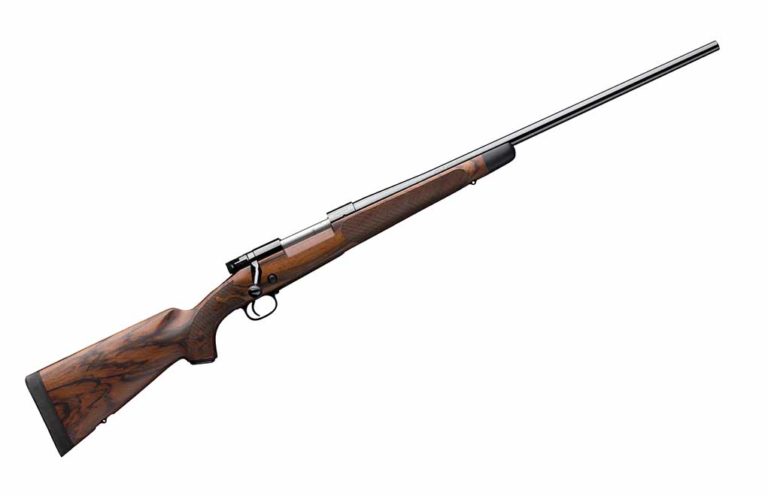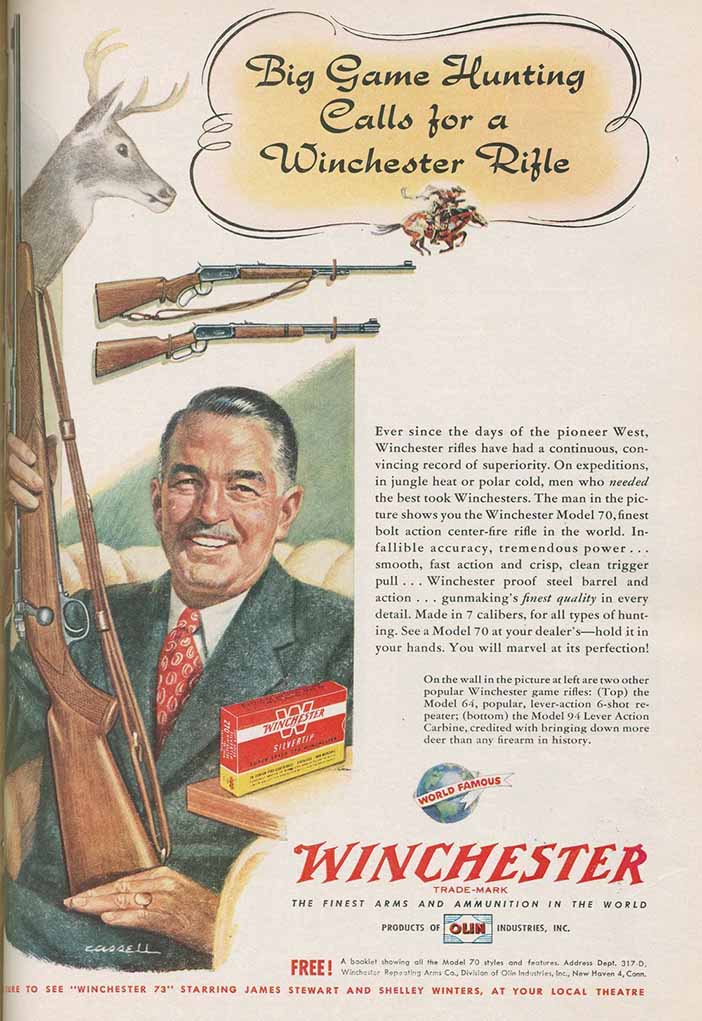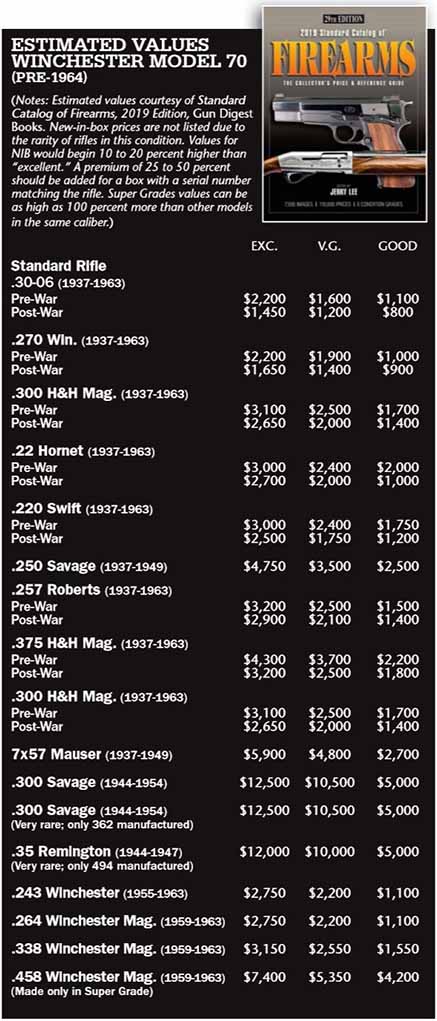

The rifleman's rifle, the Winchester Model 70 still stirs shooters souls.
What Made the Pre-'64 Model 70 So Desirable:
- Oversized Mauser claw extractor
- Excellent hand checkering
- Bolt handled allowed for a lower scope position
- Recoil lug and bedding system created a stiffer action
- Just plain accurate
For many years, Winchester’s Model 70 was the standard by which all other centerfire bolt-action rifles were compared. Introduced in 1936, it was a time when bolt-actions were well on the way to replacing the great lever guns of the prior century. Our doughboys who served in World War I with 1903 Springfields came home with an appreciation of the inherent accuracy and rugged reliability of bolt-actions.
During the Great War, the major American gun companies were already making plans to develop new firearms for the civilian market. Not long after the war was over, Remington, along with Winchester and Eddystone Arsenal, had supplied troops with the Model 1917 Springfield and developed a civilian version in .30-06 known as the Remington Model 30. Savage unveiled its first bolt-action—the Model 1920 Hi-Power in .250 Savage and .300 Savage. Winchester engineers had been working on a bolt gun for several years and, in 1925, the company introduced the Model 54, chambered for the .30-06 and a new cartridge known as the .270 Winchester.
Winchester’s Model 54
The Model 54 combined some features of the M1903 Springfield, the M1917 and the M98 Mauser. It was offered in 10 different model variants and 10 chamberings and was generally well-received in the marketplace.
Learn More About Legendary Winchester
- 9 Greatest Winchester Rifles And Shotguns Ever Made
- Restored To Life: Winchester 1886
- Winchester Model 94: Receivers
- Winchester Model 1897 Riot Gun
- Classic Firearms: Winchester Model 62
But timing is everything, and the 1929 market crash and subsequent Great Depression kept sales low, not just for the Model 54, but for other Winchester models as well.

After 65 years of numerous management changes and being controlled most of that time by one family, Winchester Repeating Arms was forced into receivership. On December 22, 1931, Western Cartridge Company purchased the gunmaker. The Model 54 had seen several improvements since 1925, but under the new management, the engineers made plans for a totally new rifle.1
The Model 70
The Model 70 was announced on January 1, 1937. It had some of the same features as the Model 54 but with numerous improvements. These included a hinged floorplate, straighter stock with superior checkering, a forged-steel trigger guard and an adjustable trigger based on the override trigger of the Model 52 .22 rimfire target rifle, which was well-known for its crisp letoff. Changes were made to the bolt handle and the safety lever to allow a lower scope position, as well as to the recoil lug and bedding system to obtain a stiffer action and improved accuracy.2
The Model 70 quickly gained a solid reputation for its design, accuracy and workmanship. At the time, Jack O’Connor was on his way to becoming “the dean of American gun writers,” and he referred to the new Winchester as one of the two best rifles in the world (the other being the M98 Mauser).3
Most collector interest in Winchesters is for models made before 1964—the year the company made significant changes to its manufacturing methods and gun designs. These changes gave Winchester a better position in the marketplace to compete with gunmakers that were using more-modern ways to make their products.

Among the changes made to the Model 70 were a redesigned action with a push-feed bolt instead of controlled-round feed, a free-floating barrel and a new style stock with impressed checkering. In the barrels, instead of broached rifling and cut chambers, both were cold-forged or swaged. There were many other internal changes, including a move to precision casting for many parts instead of machined bar stock, redesigned ejectors and extractors, and a wider trigger.4
Many well-known gun writers of the day were quite critical of the new Model 70, and soon, their opinions sparked a “pre-’64/post-’64” debate that continues to this day. It’s obvious that the older rifles, especially those made before World War II, have more hand fitting of parts and better polishing. However, to say that all pre-’64 rifles were “better” than all post-’64 rifles, well, that’s a great way to start an argument.
Criticisms received by the company following the introduction of the new Model 70 did not fall on deaf ears. It wasn’t long before the free-floating barrel was discontinued; and soon, there was a return to cut chambers while keeping the swaged bore and rifling. Other modifications were made through the 1970s and ‘80s; and, in 1994, there was essentially a return to the pre-’64 action on many models.4
FOOTNOTES
1, 2: The Rifleman’s Rifle, Roger Rule; 1996
3: The Rifle Book, Jack O’Connor; Alfred A. Knopf; 1964
4: Standard Catalog of Firearms, Gun Digest Books; 2019
The article originally appeared in the June 2019 issue of Gun Digest the Magazine.

Next Step: Get your FREE Printable Target Pack
Enhance your shooting precision with our 62 MOA Targets, perfect for rifles and handguns. Crafted in collaboration with Storm Tactical for accuracy and versatility.
Subscribe to the Gun Digest email newsletter and get your downloadable target pack sent straight to your inbox. Stay updated with the latest firearms info in the industry.

![Best Concealed Carry Guns In 2025 [Field Tested] Wilson Combat EDC X9S 1](https://gundigest.com/wp-content/uploads/Wilson-Combat-EDC-X9S-1-324x160.jpg)


![Best 9mm Carbine: Affordable PCCs [Tested] Ruger Carbine Shooting](https://gundigest.com/wp-content/uploads/Ruger-Carbine-Shooting-100x70.jpg)
![Best AR-15: Top Options Available Today [Field Tested] Harrington and Richardson PSA XM177E2 feature](https://gundigest.com/wp-content/uploads/Harrington-and-Richardson-PSA-XM177E2-feature-100x70.jpg)
